ROAD TESTS the HONDA CIVIC
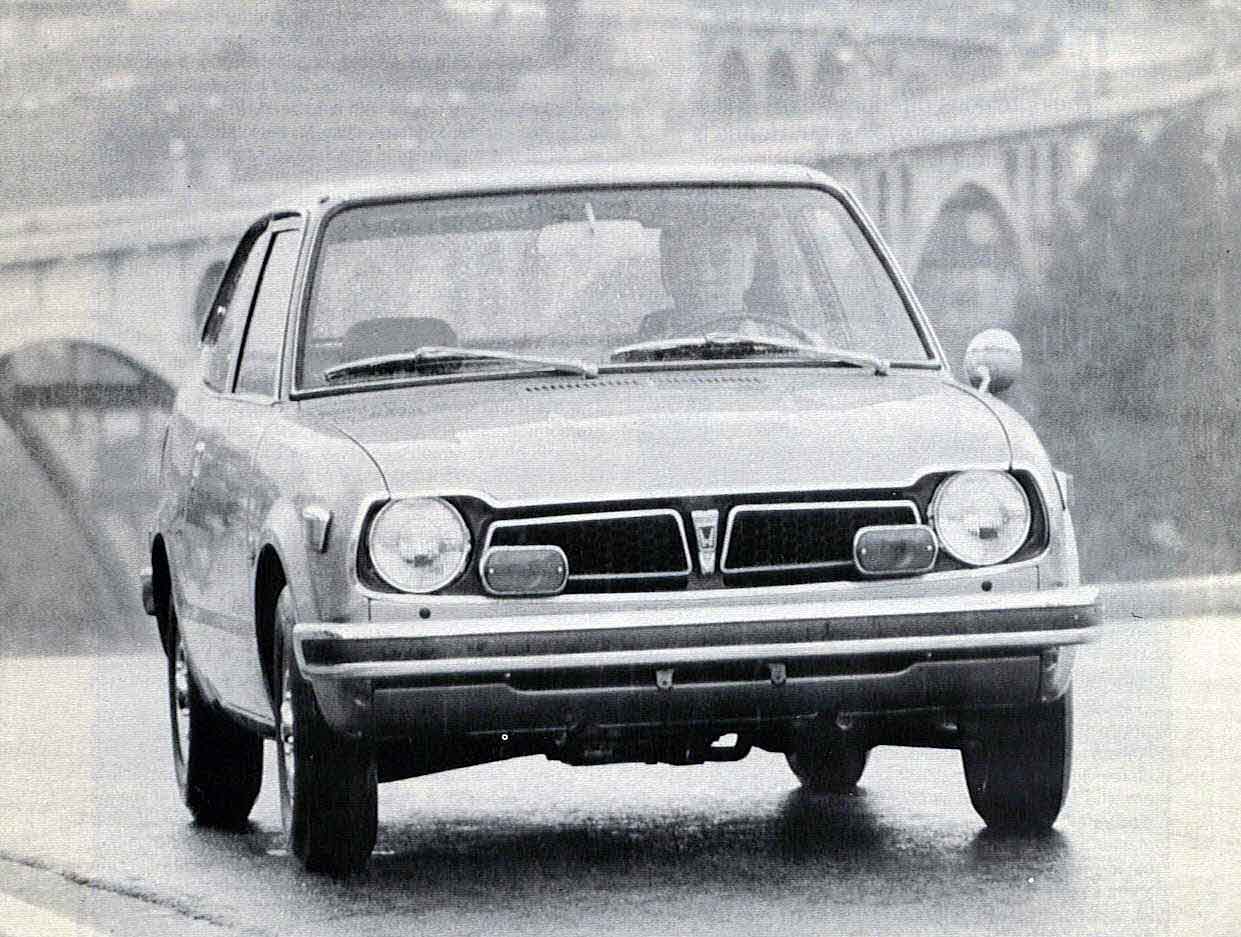
• Honda has finally become a car builder. Contrary to what your
neighbor may have told you, the 600 sedans and coupes you see nipping around the ankles of Buicks and
Biscayne's on the Los Angeles freeways are not cars. And neither was the old imitation-Sprite sports car that everybody (including your Honda dealer) has forgotten about by now. All of those devices were more like enclosed motorcycles—with four wheels as a concession to riders without balance—and they never really fooled anybody. But Honda is
canceling out of the semi-car market now. As soon as the dealers roll their current supply of 600s out the door the transition will be
complete. Because, waiting to take its place, is the new Civic, at $2150 P.O.E. a serious contender in the real car market.
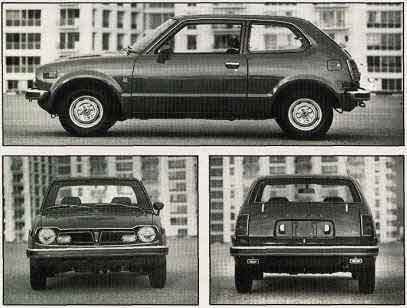 As an introduction, let us tell you that there is absolutely nothing radical nor innovative about the Civic. And that should be reassuring beyond measure to all of you potential customers who failed to appreciate the racket of the 600's unique air-cooled, upright 2-banger engine. Or who couldn't quite master the clever dash-mounted shifter. Nor is the Civic another one of those Japanese micro-cars that tremble fearfully as they cut through the bow wave of a Peterbilt. Instead, it's what Honda likes to think of as the perfect urban car (hence the name Civic, if you can follow that logic). But before you can finish stuffing the Civic into that pigeon hole, Honda spokesmen are quick to point out that it's perfectly at home on freeways and cross-country expressways as well. Another half-size car for all seasons . . . if we are to believe the manufacturer's glossy descriptions.
As an introduction, let us tell you that there is absolutely nothing radical nor innovative about the Civic. And that should be reassuring beyond measure to all of you potential customers who failed to appreciate the racket of the 600's unique air-cooled, upright 2-banger engine. Or who couldn't quite master the clever dash-mounted shifter. Nor is the Civic another one of those Japanese micro-cars that tremble fearfully as they cut through the bow wave of a Peterbilt. Instead, it's what Honda likes to think of as the perfect urban car (hence the name Civic, if you can follow that logic). But before you can finish stuffing the Civic into that pigeon hole, Honda spokesmen are quick to point out that it's perfectly at home on freeways and cross-country expressways as well. Another half-size car for all seasons . . . if we are to believe the manufacturer's glossy descriptions.
Better that you should see the Civic as an urban car, we think, and that recommendation is based purely on its size. At 139.8 inches in overall length it fits in about halfway between the true micro-cars (Honda 600 and Minis) and what Americans tend to think of as standard little cars (Fiat 128, Datsun 1200 and Toyota Corolla). And along with these compact dimensions is a corresponding light weight (1536 Ibs.). In crowded metropolitan areas the advantages of such a miniature automobile are obvious. The Civic's
maneuverability and economy are exceeded only by a motorcycle. But those credits are transformed by laws of physics into debits on the open highway. Gusty breezes feel like gale force winds and while the Civic may not tremble fearfully in the bow wake of a semi, it does cringe noticeably. None of that is bad engineering. It's just an inherent quality of small cars . . . and the reason they are best suited to urban service.
Earlier it was mentioned that there is nothing radical about the Civic's mechanical layout. It is, in fact, absolutely conventional in the Mini/Austin America/Simca 1204 mold of small cars. The Civic's in-line, 4-cylinder engine is transversely mounted in front where it drives the front wheels. The suspension is independent all around, in this case done with Mac-Pherson struts and coil springs. The transmission is a 4-speed, all-synchro device with a 2-speed Hondamatic optional. Brakes are discs in front, drums in back, and power assisted. All of this machinery is attached as simply and efficiently as possible to a passenger carrying compartment of four persons capacity. The idea is to keep mechanical intrusions to a minimum and Honda engineers have been particularly successful in this because, in addition to the absence of a drive-line tunnel which is inherent in this type of design, the wheel arches are also commendably small. The Civic is perhaps the only car of this size in which the driver doesn't have to angle his feet toward the center of the car to avoid the left front wheel housing. And it also has a full-width rear seat. So, in general, the Civic scores excellent marks in space utilization. There are limitations however. The front seats are fine. They are comfortable with reclining back rests and a good range of fore-and-aft adjustment. Adults in the six-foot range will have no complaints about leg, hip and head room. But the same cannot be said for the back. By compromising front leg room somewhat the same adults will be able to accommodate their knees in back but there is no solution to that lack of rear head room. About 5'10" is the height limit for rear seat passengers. Which strikes us as a poor trade off. Little shoe box sedans do not rely on beauty for their appeal and even if they did, ballooning the
Civic's roof up an extra inch or so wouldn't have destroyed what the critics would call classic proportions. But it would have made the car more useful and that, it would seem, is what this kind of machine is all about.
Instead, Honda has concentrated on thorough engineering to broaden the Civic's operating range. And they have been successful. More than anything else, Honda is known for its engines. The one in the Civic is a charmer. And it makes enough horsepower so that no one can ever classify the car as underpowered. Its acceleration is not only better than that of VWs and other small displacement competitors like the Toyota Corolla 1200 but it also exceeds that of the standard engine Pinto as well. And with a top speed of 88 mph, the Civic is no sitting duck on the freeway either.
All of this power comes from a slightly long stroke, 1200cc single overhead camshaft Four. Unlike the air-cooled 600, this one is water-cooled, which does wonders for noise level. It idles quietly, no louder than a conventional Detroit intermediate sedan, and even the 82 dBA it generates under wide-open throttle acceleration is moderate for this kind of car.
Cruising is peaceful if you are content to move along at about 60 mph, but the volume increases markedly between 65 and 70 mph to a level of 80.5 dBA at the higher speed. This provides a kind of psychological barrier to speeding because, even though the Civic is powerful enough to easily cruise at relatively high speeds, we noticed a tendency to stay right at 65 mph. This tends to emphasize—and unfairly so, we might add—the urban nature of the Civic. In truth, it is no noisier at high speeds than its competitors, but because it is so much quieter at low speeds it seems better suited to city traffic.
Apart from a low noise level, the Honda's engine is remarkable for the way it starts when warm. It lights instantly. Which is rare and therefore conspicuous in this day of reluctant emission-controlled engines. But it has suffered from de-smogging in other ways. Giant holes in its throttle response for one. At certain speeds, when you depress the accelerator, the car actually slows down and you have to go almost clear to the floor before it picks up again. That always happens just when you need a squirt of power to squeeze into a more advantageous spot in traffic.
While Honda engineers have been careful to provide certain basic qualities that are usually lacking in small cars— power and silence to name two—there are other areas that did not receive proper attention. One of them is clutch action.
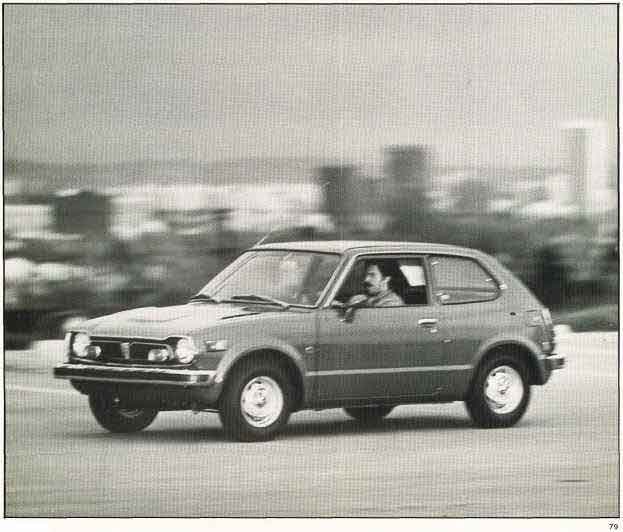 It chatters vigorously when you start out. And no amount of feathering the pedal will drive around it. It chatters vigorously when you start out. And no amount of feathering the pedal will drive around it.
The front steering geometry is not a polished design either. The Civic has enough power (the 600 didn't) so that you can feel the front wheels struggling to straighten themselves as you accelerate through a tight turn. This will do no harm to either you or the car... but it does make more work for the driver, work that doesn't have to be there if the designers had drawn their lines differently.
The final objection is ride quality. It's plenty hard, more so than any of the competition. And it pitches too. Those rocking horse motions have all but been forgotten by drivers of modern cars, particularly on freeways, but the Honda will revive your memory. Granted, the smaller the car, the harder it is to make it ride well but Honda should have tried harder.
The Civic is far more successful if you look at it from the point of view of driver convenience. The interior layout is highly efficient. The doors are big enough to provide easy access and once inside you're spared the bus-like driving position that was always a part of the Mini and the Austin America. Honda engineers have managed to prop the steering wheel up at a civilized angle and position all of the controls where they can be found without a second look. At first the choice of
materials and the style of the interior decor seem exactly typical of low-buck Japanese cars. Plenty of exterior-colored
sheet metal meets the eye and the door panels are simply islands of vinyl on an enameled expanse of metal door. But then you begin to notice the clever touches. The instrument panel is enormously successful. Two gauges are clustered in one pod directly before the driver and the rest of the panel's width is given over to a package tray, much like that in the BMW 3.0CS. And instead of fixing a console to the floor between the seats, there is a tray outboard of each front seat down by the sills (if nothing else, handier than penny loafers for keeping toll money). As is common these days, much of the dash and other interior fittings are made up of molded plastic panels, but those in the Honda are of exceptional quality. The result of all of this is that while the Civic is clearly a small car in every sense of the word it is not, happily enough, cheap.
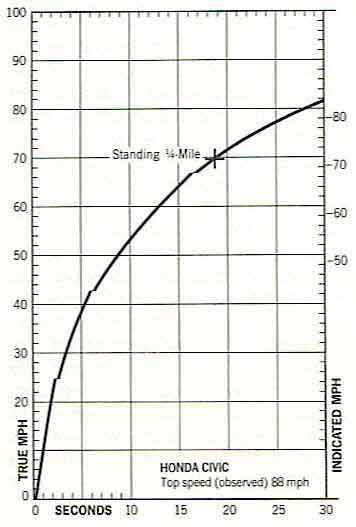 In fact, if you aren't careful, you could end up with an expensive Civic because Honda dealers stock enough options— everything from automatic transmissions through roof racks to air conditioners. But the
basic Civic comes in two denominations; the two-door sedan, which is the subject of this test, and the three-door Hatchback. They are exactly alike except that the conventional
trunk lid and fixed rear seat of the sedan are replaced by an upward-hinged rear window and fold-down seat in the Hatchback. If hauling capacity is a serious concern, you should opt for the Hatchback even though the high
leftover situation in back is inconvenient. The sedan's trunk is simply too small. The compartment's vertical dimension is enough for two medium size suitcases laid flat and stacked one atop the other but once inside there isn't enough depth to allow the door to close. So the utility of the Hatchback will cost you an additional $100.
In fact, if you aren't careful, you could end up with an expensive Civic because Honda dealers stock enough options— everything from automatic transmissions through roof racks to air conditioners. But the
basic Civic comes in two denominations; the two-door sedan, which is the subject of this test, and the three-door Hatchback. They are exactly alike except that the conventional
trunk lid and fixed rear seat of the sedan are replaced by an upward-hinged rear window and fold-down seat in the Hatchback. If hauling capacity is a serious concern, you should opt for the Hatchback even though the high
leftover situation in back is inconvenient. The sedan's trunk is simply too small. The compartment's vertical dimension is enough for two medium size suitcases laid flat and stacked one atop the other but once inside there isn't enough depth to allow the door to close. So the utility of the Hatchback will cost you an additional $100.
After driving the Civic one conclusion is inescapable: Honda has firmly committed itself to the car business. And to back up that observation, the word from the head office is that the number of dealers will be doubled in the next year. Since the 600 is being discontinued, that leaves the Civic as the main and only fare. For convenience on congested in ner city streets it is without peer and to drive it is a better—much better—Austin America. Many cars have entered the marketplace with less.
FUEL ECONOMY RANGE mpg
Vehicle type: Front engine, front-wheel-drive, 4-passenger Honda Civic
Importer: American Honda Motor Co., Inc. 100 West Alondra Boulevard Gardenia, California 90247
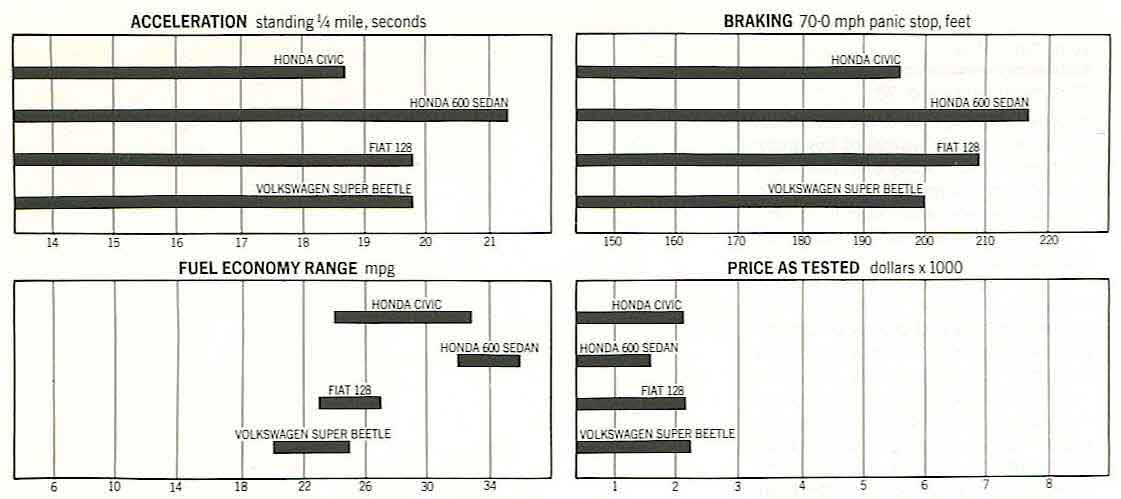
STEERING
Type ................................... Rack and pinion
Turns lock-to-lock................................... 3.1
Turning circle curb-to-curb ........................31.0 ft
BRAKES
F:............................... 8.8-in disc, power assist
R: ........................ 7.1 x 1.5-in drum, power assist |
Price as tested: $ 2300.00
(Manufacturer's suggested retail price, including all options listed below, dealer preparation and delivery charges, does not include state and
local taxes, license or freight charges)
Options on test car: Base car, $2150.00; AM radio, $50.00; dealer preparation, $100.00 |
DRIVE TRAIN
Gear Ratio 1 3.00 II 1.79 III 1.18 IV 0.82 Mph/lOOOrpm 4.3 7.2 10.8 15.6 Max. test speed 25 mph(6000 rpm) 43 mph (6000 rpm) 67 mph (6200 rpm) 88 mph (5600 rpm) |
SUSPENSION
Front: Ind, McPherson strut, coil spring, anti-sway bar
Rear: Ind, McPherson strut, coil spring |
ENGINE
Type: 4-in-line, water-cooled, aluminum block and head, 5
main bearings Bore x stroke ..............2.76x2.99 in, 70.0x76.Omm
Displacement .................................. 71.3 cu in, 1169cc
Compression ratio ............................ 8.3 to one
Carburetion ..................................... 1 x 2-bbl
Valve gear .......................................Belt driven single overhead cam
Power (SAE net) ............................ 50 bhp @ 5500 rpm
Torque (SAE net) ........................... 59 Ibs-ft ® 3000 rpm
Specific power output .... .............. ...0.70 bhp/cu in, 42.9 bhp/liter |
WHEELS AND TIRES
Wheel size ........................... 12 x 4.5-in
Wheel type ............................Stamped steel, 4-bolt
Tire make and size ..................Bridgestone Skyway H 6.00 S12
Tire type .................................Tubeless, bias ply
Test inflation pressures, F/R .....24/24 psi
Tire load rating.........................845 Ibs per tire @ 32 psi |
DIMENSIONS AND CAPACITIES
Wheelbase ...................................... 86.6 in
Track, F/R ..................................... 51.2/50.4 in
Length ............................................139.8 in
Width............................................. 53.3 in
Height ........................................... 53.0 in
Ground clearance.............................7.1 in
Curb weight................................... 1536 Ibs
Battery capacity ............................ 12 volts, 45 amp-hr
Alternator capacity .........................420 watts
Fuel capacity ................................. 10.0 gal
Oil capacity ....................................3.2 qts
Water capacity .............................. 4.2 qts |
PERFORMANCE
Zero to Seconds
30 mph ....................................3.2
40 mph ....................................5.2
50 mph ....................................8.6
60 mph ...................................12.9
70 mph ................................... 18.8
80 mph ...................................28.0
Standing'/4-mile ......................18.7 sec @ 69.9 mph
Top speed (observed) ............. 88 mph
70-0 mph................................ 196 ft (.84 G)
Fuel mileage............................. 24-33-mpg on regular fuel
Cruising range ......................... 240-330 mi
|
|

